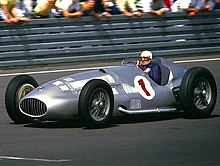Rudolf Uhlenhaut


Rudolf Uhlenhaut (born July 15, 1906 in London ; † May 8, 1989 in Stuttgart ) was a German engineer and later a member of the board of Daimler-Benz .
Career
Uhlenhaut, the son of an Englishwoman and a German , was born in London in 1906, where his father ran the Deutsche Bank branch . From there the family moved first to Brussels and later to Bremen . Due to his preference for skiing, he completed his studies in mechanical engineering at the University of Munich . In 1931 he came to Daimler-Benz in Stuttgart as a young engineer and began his career under Fritz Nallinger in the testing department. There he experimented on carburettors and worked on the development of the Mercedes 170 V , among other things .
In 1936 Uhlenhaut took over the vacant management of the racing car department. In test drives, Uhlenhaut, who was also a talented driver, found the weaknesses in the too soft chassis of the “ Silver Arrow ” W 25 . After extensive revision, the new W 125 became the superior car of the Grand Prix European Championship in 1937 and Rudolf Caracciola with it became European Champion. The car was replaced by the W 154 , which dominated the 1938 and 1939 seasons . His almost "lightning-fast" design of the 1.5-liter W 165 car for the Gran Premio di Tripoli 1939 , which had been downgraded from the 3-liter championship to the Voiturette class at the latest possible time - probably around the To give the Alfa Romeo Type 159, which was the leader in this group at the time, a chance of victory - which Alfa Romeo hardly had with the 3-liter racing cars in the large class.
Due to the Second World War , it took until the early 1950s for Mercedes to build a competitive sports car again. Uhlenhaut's idea was to build a racing sports car with the 300 engine . The W 194 (Mercedes 300 SL), which surprisingly won important sports car races in 1952 , then became the legendary "Gullwing Coupé" 300 SL ( W 198 ) for the road in 1954 .
Uhlenhaut was always concerned with improving the racing cars and was pushing it to the max. Famous are incidents that happened to racing drivers. In 1955, driver Juan Manuel Fangio said that the car was not yet optimally prepared. Uhlenhaut then got up after an opulent lunch in a suit and tie, got into the vehicle and circled the Nürburgring three seconds faster than the world champion. Back at Fangio, Uhlenhaut told him that he would like to practice a little more.
Rudolf Uhlenhaut never owned a car of his own. But he is identified with various vehicles. The most famous is the so-called “ Uhlenhaut Coupé ” based on the open 300 SLR eight-cylinder, with which u. a. Stirling Moss won the Mille Miglia in 1955 together with Denis Jenkinson . For the 1956 racing season, it was given a closed body to offer drivers greater comfort on long journeys. But Mercedes-Benz withdrew from motorsport after the accident at the Le Mans 24-hour race in 1955 . Uhlenhaut used the vehicle regularly in the years that followed. It was significantly faster (and louder) than the 300 SL .
He was later on the board of directors of the Stuttgart-based company and, most recently, until his retirement in autumn 1972, he was head of car development. In old age he needed a hearing aid , which he attributed to the constant driving of his bolides.
Honors
- 1954: Cross of Merit (Steckkreuz) of the Federal Republic of Germany
- December 7, 1972: Dr.-Ing. eh the Technical University of Munich
literature
- Wolfgang Scheller, Thomas Pollak: Rudolf Uhlenhaut: engineer and gentleman . Heel Verlag , Königswinter 2015, ISBN 978-3-958-43150-8
Web links
- Rudolf Uhlenhaut, the developer. The brilliant engineer is the father of the SL and another legendary Fahrbeuge from Mercedes-Benz. In: Mercedes-Benz AG . www.mercedes-benz.com, September 1, 2017, accessed on May 15, 2020 .
- Rudolf Uhlenhaut. www.motorsportmemorial.org, accessed on May 15, 2020 (English).
- Rudolf Uhlenhaut - The man who gave the star wings. www.classicdriver.com, September 1, 2017, accessed May 15, 2020 .
- Christoph Ditzler: Rudolf Uhlenhaut - engineer and gentleman (book review). www. Zwischengas.com, December 23, 2015, accessed May 15, 2020 .
- Jörg Enger: Dossier: Rudolf Uhlenhaut. In: Mercedes-Benz Veteranen Club von Deutschland e. V. ticker.mercedes-benz-passion.com, June 1, 2020, accessed on May 15, 2020 .
- Two biographies: Richard Seaman and Rudolf Uhlenhaut. In: Daimler AG . media.daimler.com, accessed May 15, 2020 .
Individual evidence
- ↑ This honored his basic achievements in improving driving behavior and driving safety. (Austro-Motor 28.1971, No. 1, p. 45)
| personal data | |
|---|---|
| SURNAME | Uhlenhaut, Rudolf |
| BRIEF DESCRIPTION | German engineer, member of the Board of Management of Daimler-Benz AG |
| DATE OF BIRTH | July 15, 1906 |
| PLACE OF BIRTH | London |
| DATE OF DEATH | May 8, 1989 |
| Place of death | Stuttgart |

